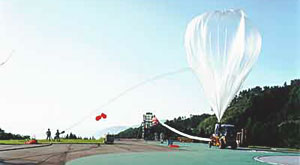TOP > Topics > 2001 > The Scientific Ballooning Experiments at SBC
![]()
The Scientific Ballooning Experiments at SBC
The First series of Scientific Ballooning Experiments in the year 2001 were conducted at Sanriku Balloon Center from May 15 through June 5. Five scientific balloons comprising two BT1s, one B15, one B80 and one BT150 were launched.
BT1-5 was launched on May 18. The purpose of this experiment was to verify communication functions, such as telecommunication and command transmission, of a very small, handmade satellite developed primarily by engineering students of Tokyo Institute of Technology. The operations of onboard instruments and various communication functions were monitored in Sanriku, Tokyo and Sugadaira. From this experiment, students gained valuable experience relevant to the management of satellite mission.
BT1-4 was launched on May 20. The purpose was to verify communication functions assuming telecommunication between a very small satellite in orbit and a ground center. The very small satellite has been developed primarily by engineering students of the University of Tokyo. Data reception and command transmission from Sanriku, Tokyo and Sugadaira were successfully performed enabling two-way communication between a ground center in Tokyo and a point 420km away from it. Valuable data for the launch of a very small satellite were obtained.
|
B150-6 was launched on May 23. With students of Aoyama Gakuin University taking the initiative, it was conducted to investigate the intra-galactic diffusion of cosmic rays and their origin through measuring the spectrum of high-energy primary electrons using an emulsion chamber. Pictures obtained by recovered observation instruments have already been developed and are now being analyzed. These analytical results are expected to clarify the spectrum of high-energy primary electrons in the 100GeV area.
B80-5 was launched on May 30. The purpose of this experiment developed primarily by the students of Tohoku University was to collect stratospheric atmosphere using the liquid-helium cryogenic sampling system. Each 20-liter air sample on an atmospheric pressure basis was successfully collected at 11 almost-evenly spaced points at different altitudes between 14 and 34km. The sampled air will be sent to the institutes concerned and will be measured for variant component density and isotopes. It is expected that the analytical data obtained will be of great help in understanding the atmospheric circulation in the stratosphere and the photochemical reaction process.
B15-82 was launched on June 4. The purpose of this experiment conducted at sunset was to test flight performance of an auto-ballast system that maintains the altitude of scientific balloon by automatically dropping ballast. The desired objectives were accomplished by creating a pseudo-sunset several times using an air-release valve and conducting a functional test.
August 17, 2001





